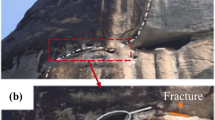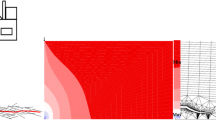Abstract
Numerical analysis of growth of fractures from a wellbore under sleeve fracturing conditions demonstrates the impact of in situ stresses on initiation and propagation behavior of primary and secondary cracks at both field and lab scale. Crack initiation and propagation behavior are simulated in a Finite Element framework employing plane-strain cohesive element along the candidate crack paths. The model has been validated by benchmarking to Kirsch’s solution as well as by comparing predictions to results of a laboratory block test. Indeed, the field scale simulation results show that the first fracture always orients with the opening in direction of maximum in situ stress while the opening direction of the second fracture can vary with different in situ stresses. Furthermore, the deviation of wellbore displacement from the Kirsch solution due to the fracture initiation can be captured by the simulation, which can be further applied to interpret the initiation pressure and location of cracks based on field test data. In the context of past contributions on sleeve fracturing, these numerical results demonstrate that a relatively large region near the crack tip undergoes inelastic deformation, which contrasts with the assumptions required to treat this problem using linear elastic fracture mechanics (LEFM). Notably, the finite tip plasticity appears to eliminate unstable jumping of the crack length(s) predicted by LEFM solution. The finite tip plasticity also leads to the prediction that the secondary fracture often occurs in orientations other than 90° to the primary fracture. In contrast, the LEFM solution predicts none of this growth because the stress intensity factor (SIF) never reaches the rock fracture toughness in spite of the fact that these alternate orientations have the largest SIFs over limited periods of time. Finally, the finite tip plasticity shows the strength of materials approach (based on stress analysis around the hole) to give a lower bound estimate of the pressure required for crack extension.



















Similar content being viewed by others
References
ABAQUS (2011) ABAQUS version 6.11 analysis user’s manual. Dassault Systèmes Simulia Corp, Providence
Barenblatt GI (1962) The mathematical theory of equilibrium cracks in brittle fracture. Adv Appl Mech 7(1):55–129
Bazant ZP, Planas J (1997) Fracture and size effect in concrete and other quasibrittle materials, vol 16. CRC Press, Boca Raton
Chandler N (1989) An energy approach to sleeve fracture stress measurements. Ph. D. Dissertation, University of Manitoba, Winnipeg
Charsley AD, Martin CD, McCreath DR (2003) Sleeve-fracturing limitations for measuring in situ stress in an anisotropic stress environment. Int J Rock Mech Min Sci 40(1):127–136
Detournay E, Jeffrey RG (1986) Stress conditions for initiation of secondary fractures from a fractured borehole. In: Proceedings of the international symposium on rock stress and rock stress measurements, Stockholm, p 281–288
Dugdale DS (1960) Yielding of steel sheets containing slits. J Mech Phys Solids 8(2):100–104
Hubbert MK, Willis DG (1957) Mechanics of hydraulic fracturing. Trans AIME 210:153
Kirsch C (1898) Die theorie der elastizitat und die bedurfnisse der festigkeitslehre. Zeitschrift Des Vereines Deutscher Ingenieure 42:797–807
Lecampion B (2012) Modeling size effects associated with tensile fracture initiation from a wellbore. Int J Rock Mech Min Sci 56:67–76
Ohanian OJ, VandenBerge DR, Davis MA (2019) Distributed measurement of minimum and maximum in situ stress in substrates, US Patent Application US20190064387A1
Saouma VE, Natekar D, Hansen E (2003) Cohesive stresses and size effects in elasto-plastic and quasi-brittle materials. Int J Fract 119(3):287–298
Segura JM, Carol I (2010) Numerical modelling of pressurized fracture evolution in concrete using zero-thickness interface elements. Eng Fract Mech 77(9):1386–1399
Serata S, Sakuma S, Kikuchi S, Mizuta Y (1992) Double fracture method of in situ stress measurement in brittle rock. Rock Mech Rock Eng 25(2):89–108
Stephansson O (1983) Rock stress measurement by sleeve fracturing. In: Proceedings of the fifth congress on International Society for Rock Mechanics, Melbourne, p F129–F137
Yao Y (2012) Linear elastic and cohesive fracture analysis to model hydraulic fracture in brittle and ductile rocks. Rock Mech Rock Eng 45(3):375–387
Acknowledgements
Support is provided from Luna Innovations as a subaward (3723.01/PITT) on a Shell GameChanger Grant (CW235436). This support, as well as permission to publish, is gratefully acknowledged. This research was supported in part by the University of Pittsburgh Center for Research Computing through the resources provided. The authors also greatly appreciate constructive and useful discussions with Tom Doe, especially of the technical history of sleeve fracturing, and with Alexei Savitski and Haiyong Cai and other colleagues at Shell with respect to the integration of simulations with field measurements. Data used to generate figures in this paper are available at http://d-scholarship.pitt.edu/id/eprint/40030.
Author information
Authors and Affiliations
Corresponding author
Additional information
Publisher's Note
Springer Nature remains neutral with regard to jurisdictional claims in published maps and institutional affiliations.
Appendix
Appendix
Assuming that the load application in the lab can be replaced with a far-field stress in an infinite domain, A field-scale simulation with same material properties and in situ stresses with lab-scale test is further provided to see if the results from lab experiments can predict the field test.
The crack opening versus pressure loading is plotted in Fig. 20, which provides the initiation pressure for the first, second crack and third crack. Indeed, the difference between the initiation pressure of the secondary and tertiary crack is very small. However, the secondary crack has not been suppressed by the tertiary crack, which is different from the lab-scale simulation results with finite domain where only the 90° crack grows. Furthermore, a comparison of initiation pressure for first and second cracks between simulation and lab test (Table 5) indicates substantial deviation between the finite and infinite models, with the predicted pressure for primary crack growth with infinite domain simulation is about 54% higher than the finite domain lab experiment and the predicted pressure for secondary crack growth with infinite domain simulation is about 82% higher than the finite domain lab experiment.Figure
20 shows the crack initiation and propagation behavior predicted by this infinite domain numerical model. It is qualitatively similar to the behavior observed in the lab in that a primary crack growth in the plane upon which the smaller stress is acting. Also, upon increasing the pressure inside the central hole, a secondary crack grows in the plane with an angle 67.5°, although this secondary crack is suppressed much more quickly in the lab-scale model. Then, a tertiary crack initiates in the plane with an angle 90°, as in the lab-scale model. The other 10 potential planes of crack growth did not show substantial fracturing, also in agreement with a lack of damage observed in the tested block.
The block size was increased relative to the hole size until the finite domain simulation results effectively converge to the infinite domain results. Results are shown in Table 5. Convergence is observed when the hole size to block size ratio is 1/10, and even then, only when the pressure loading uniformly distributing along the whole boundary. Such a pressure distribution could be obtained with fluid-filled flat jack loading, but would not be expected when loading is applied with hydraulic pistons. Indeed, the details of the piston size (i.e. applied loading area) and thickness of the steel platens are observed through the experience of this study to have a strong effect on the predicted initiation pressures and, therefore, are chosen to closely match the actual lab configuration. Still, even if ideal loading is applied, the block size requirement is problematic because the required hole size needed to provide space for the packer and its accompanying sensors means that a 10 × larger block size is impractical. So, for most practical purposes, the comparison between finite domain and infinite domain results further emphasize the significance of boundary conditions for lab-scale simulation. If one wishes to simulate the lab experiments, it is important to use a purpose-built simulator that accounts for the details of the boundary conditions rather than simply assuming that the lab experiments approximates an infinite domain.
The predicted initiation pressures are somewhat sensitive to CZ properties. To explore this sensitivity, lab-scale simulations with different cohesive element properties are carried out while the boundary and loading conditions are set to match the actual lab configuration. The comparison of these simulation results is listed in Table 6, which shows that all 3 properties impact initiation pressures. Basically, the initiation pressure of first and secondary crack is increasing as α increases while the cohesive element strength and cohesive element energy Gc are held to be the same so that only α is varying. This approach is the same for Gc and Tmax. Therefore, by comparing with initiation pressure of first and secondary crack observed from laboratory experiment results, one group of CZ properties is selected to be applied in the final lab-scale simulation (see Table 3). Then the lab-scale simulation with actual lab configuration can provide initiation pressure that is the closest to the experiment results with this group of CZ properties.
Rights and permissions
About this article
Cite this article
Huang, Y., Zolfaghari, N., Ohanian, O.J. et al. Numerical Simulation of Sleeve Fracturing for In Situ Stress Measurement Using Cohesive Elements and Its Implications. Rock Mech Rock Eng 54, 4505–4522 (2021). https://doi.org/10.1007/s00603-021-02554-4
Received:
Accepted:
Published:
Issue Date:
DOI: https://doi.org/10.1007/s00603-021-02554-4





